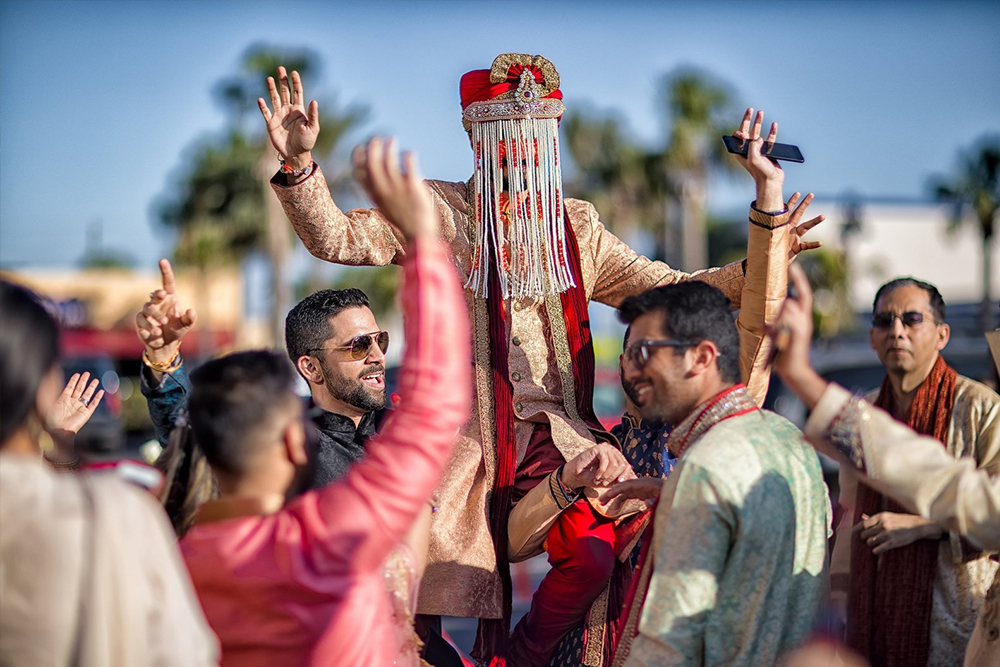Unveiling the Baraat Tradition
The Baraat ceremony is a cherished tradition in Indian weddings, symbolizing the groom’s joyous journey to the wedding venue amidst music, dance, and festivity. This vibrant procession not only marks the groom’s arrival but also signifies the union of two families and communities. Let’s delve into the essence of the Baraat, exploring its cultural significance, ceremonial rituals, and the modern-day interpretations that make it a highlight of Indian weddings today.In Indian weddings, the Baraat is more than just a procession; it’s a grand spectacle that encapsulates the celebratory spirit and cultural heritage of the occasion. The groom, accompanied by his family and friends, embarks on a joyous journey to the wedding venue, often riding a decorated horse or carriage, amidst the rhythmic beats of traditional music and the energetic dance of the baraatis (wedding guests).

Cultural Significance: Bridging Traditions and Celebrations
The Baraat ceremony holds deep cultural significance, rooted in ancient customs that symbolize auspicious beginnings and the joining of two families. It signifies the groom’s readiness and excitement to start a new chapter in his life with his bride. This ceremonial entry also serves as a joyous proclamation of the wedding festivities, announcing to the community the union of two individuals and their families.
Traditional Elements: Music, Dance, and Rituals
Central to the Baraat is the lively music played by a traditional band, which includes instruments like the dhol (drum), shehnai (wind instrument), and nagada (kettle drum). The rhythmic beats create an infectious energy, encouraging guests to dance in celebration. The groom, adorned in traditional attire often complemented with a sehra (floral veil), leads the procession with grace and enthusiasm, accompanied by his close relatives and friends who participate in the revelry.
Modern Interpretations: Infusing Personal Touches
While steeped in tradition, modern weddings often infuse personal touches into the Baraat ceremony. Some grooms opt for unique modes of transportation such as vintage cars, motorcycles, or even extravagant chariots, adding a touch of novelty to the procession. Additionally, couples may incorporate thematic elements or favorite songs into the musical repertoire, reflecting their individual personalities and shared interests.
Community Celebration: Uniting Families and Guests
Beyond its ceremonial significance, the Baraat fosters a sense of community and togetherness among wedding guests. It serves as an opportunity for both families to come together in joyous celebration, forging bonds and creating lasting memories. Guests enthusiastically participate in the festivities, dancing alongside the groom and his entourage, creating an atmosphere of happiness and camaraderie.
Symbolism and Rituals: Blessings and Auspicious Beginnings
As the Baraat reaches the wedding venue, the groom is traditionally welcomed by the bride’s family with warmth and hospitality. Rituals such as the milni (meeting of families) and the exchange of garlands symbolize the merging of two families and the acceptance of the groom into the bride’s household. Blessings are bestowed upon the couple for a prosperous and harmonious married life ahead.
Embracing Tradition with Joy and Splendor
The Baraat ceremony epitomizes the essence of Indian weddings—a celebration of love, unity, and cultural richness. It is a momentous occasion that blends ancient traditions with contemporary expressions of joy and festivity. Whether adhering strictly to customs or incorporating modern twists, the Baraat continues to be a cherished ritual that unites families, delights guests, and heralds the beginning of a new journey for the bride and groom.
Embrace the magnificence of the Baraat and its significance in Indian weddings. Celebrate this vibrant tradition with splendour, joy, and the promise of everlasting happiness as two lives embark on a beautiful journey together.
